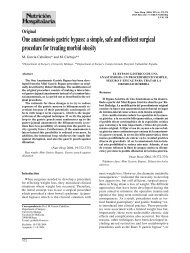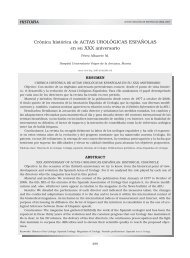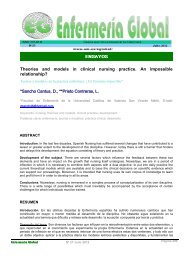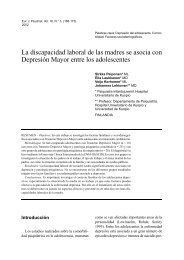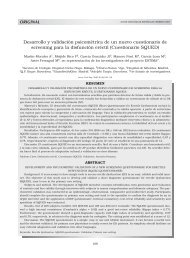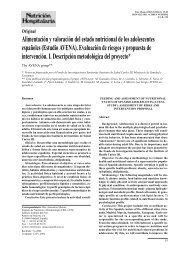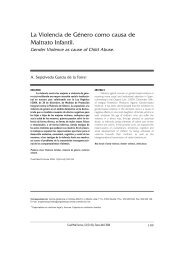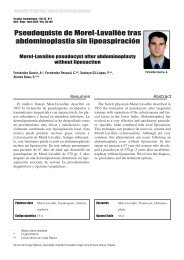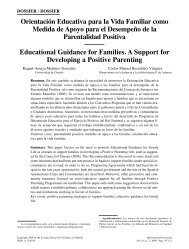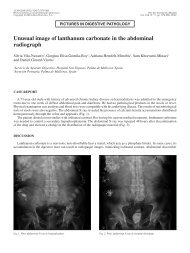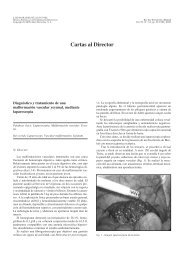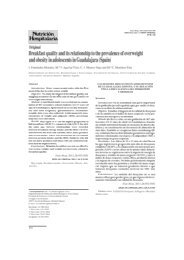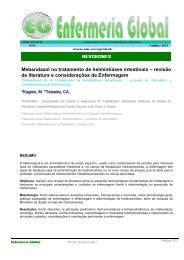digestibilidad aparente de dietas con probióticos o ... - SciELO España
digestibilidad aparente de dietas con probióticos o ... - SciELO España
digestibilidad aparente de dietas con probióticos o ... - SciELO España
Create successful ePaper yourself
Turn your PDF publications into a flip-book with our unique Google optimized e-Paper software.
DIGESTIBILIDAD APARENTE DE DIETAS CON PROBIÓTICOS O<br />
FITASA PARA POTROS MANGALARGA MARCHADOR #<br />
APPARENT DIGESTIBILITY OF DIETS WITH PROBIOTICS OR<br />
PHYTASE IN MANGALARGA MARCHADOR FOALS<br />
Moura, R.S. <strong>de</strong> 1A *, Saliba, E.O.S. 1B , Almeida, F.Q. 2 , Lana, A.M.Q. 1C , Moreira, D.C.A. 3 ,<br />
Silva, V.P. 1D , Moss, P.C.B. 1E , Pereira, R.V.G. 1F , Costa, M.L.L. 1G y Rezen<strong>de</strong>, A.S.C. 1H<br />
1Escola <strong>de</strong> Veterinária. Universida<strong>de</strong> Fe<strong>de</strong>ral <strong>de</strong> Minas Gerais (UFMG). Pampulha. Belo Horizonte-MG.<br />
A B C Brasil. *raquelmourabr@yahoo.com.br; saliba@vet.ufmg.br; lana@vet.ufmg.br;<br />
D E F zootenista_ufrrj@yahoo.com.br; patriciacbmoss@ig.com.br; vitarele@yahoo.com.br;<br />
G H lindomarciacosta@yahoo.com.br; adalgiza@vet.ufmg.br<br />
2Departamento <strong>de</strong> Medicina e Cirurgia. Instituto <strong>de</strong> Veterinária. Universida<strong>de</strong> Fe<strong>de</strong>ral Rural do Rio <strong>de</strong> Janeiro<br />
(UFRRJ). Brasil. falmeida@ufrrj.br<br />
3Haras Catuni. Montes Claros. Minas Gerais. Brasil. dalton@catuni.com.br<br />
PALAVRAS CHAVE ADICIONAIS<br />
Enzimas. Equinos. Lactobacillus. LIPE ® .<br />
Saccharomyces cerevisiae.<br />
RESUMEN<br />
El uso <strong>de</strong> aditivos se ha <strong>de</strong>sarrollado mucho<br />
actualmente, <strong>con</strong> el fin <strong>de</strong> mejorar el aprovechamiento<br />
<strong>de</strong> la dieta. El presente trabajo se realizó<br />
<strong>con</strong> el objetivo <strong>de</strong> evaluar los efectos <strong>de</strong> la<br />
suplementación <strong>con</strong> <strong>probióticos</strong> o fitasa sobre la<br />
<strong>digestibilidad</strong> <strong>aparente</strong> (DA) <strong>de</strong> los nutrientes en<br />
24 potros (16 machos y 8 hembras) Mangalarga<br />
Marchador <strong>con</strong> 241,6 ± 23,2 días <strong>de</strong> edad y 216,7<br />
± 27,8 kg <strong>de</strong> peso vivo (PV). El experimento tuvo<br />
duración <strong>de</strong> 28 días (23 para la adaptación y cinco<br />
para la recogida <strong>de</strong> muestras <strong>de</strong> heces) y la dieta<br />
basal se compuso <strong>de</strong> pasto <strong>de</strong> Cynodon y pienso<br />
comercial (1,2 kg /100 kg PV), a<strong>de</strong>más <strong>de</strong> agua y<br />
sal mineralizada ad libitum. Los tratamientos fueron:<br />
dieta basal (T1); dieta basal + 5 g/día <strong>de</strong> 10 9<br />
UFC/g <strong>de</strong> levadura S. cerevisiae (T2); dieta basal<br />
+ 2 g/día <strong>de</strong> 10 8 UFC/g <strong>de</strong> bacterias B. bifidum, E.<br />
faecium, L. acidophilus, L. plantarum y 10 5 UFC/<br />
g <strong>de</strong> levadura S. cerevisiae (T3); y dieta basal +<br />
1250 FTU (unida<strong>de</strong>s <strong>de</strong> fitasa)/dia (T4). La estima-<br />
# Trabajo financiado por la Fundação <strong>de</strong> Amparo a<br />
Pesquisa do Estado <strong>de</strong> Minas Gerais (FAPEMIG) y<br />
premiado por la Real Aca<strong>de</strong>mia <strong>de</strong> Ciencias Veterinarias<br />
<strong>de</strong> <strong>España</strong> <strong>con</strong> el III Premio "Biovet<br />
2007". (Publicación autorizada).<br />
Recibido: 17-12-08. Aceptado: 22-7-09.<br />
ADDITIONAL KEYWORDS<br />
Enzymes. Horses. Lactobacillus. LIPE © .<br />
Saccharomyces cerevisiae.<br />
ción <strong>de</strong>l <strong>con</strong>sumo se realizó utilizando el indicador<br />
externo LIPE ® y la técnica <strong>de</strong> <strong>digestibilidad</strong> in situ.<br />
El diseño estadístico fue enteramente al azar, en<br />
esquema factorial 4 x 2, y las medias fueron<br />
comparadas por el test t <strong>de</strong> Stu<strong>de</strong>nt (p
males, 8 females), aged 241.6 ± 23.2 days (mean<br />
± SD/SEM), and weighing 216.7 ± 27.8 kg. The<br />
study lasted 28 days, the first 23 for diet and<br />
handling adaptation, and the last five days for<br />
fecal collection. The basal diet <strong>con</strong>sisted of<br />
Cynodon pasture and pelleted <strong>con</strong>centrate (1.2<br />
kg/100 kg body weight), as well as water and<br />
mineral salt ad libitum. There were four treatments:<br />
basal diet (T1); basal diet + 5 g/day of 10 9 CFU/g<br />
of S. cerevisiae (T2); basal diet + 2 g/day of 10 8<br />
CFU/g of bacteria B. bifidum, E. faecium, L.<br />
acidophilus, L. plantarum and 10 5 CFU/g of S.<br />
cerevisiae (T3); and basal diet + 1250 FTU/day of<br />
phytase (T4). The DM intake was estimated with<br />
an external marker (LIPE © ) associated with cecal<br />
in situ digestibility of DM. All foals were randomized<br />
by replicate using a 4 x 2 factorial, and results<br />
were compared using Stu<strong>de</strong>nt's t-test (p
PROBIÓTICOS Y FITASA EN DIETAS PARA POTROS MANGALARGA MARCHADOR<br />
investigado en <strong>dietas</strong> para aves y cerdos, a<br />
causa <strong>de</strong>l efecto que los fitatos ejercen en la<br />
absorción <strong>de</strong> los minerales. El fitato<br />
(hexafosfato <strong>de</strong> inositol) ocurre naturalmente<br />
en los complejos orgánicos <strong>de</strong> las plantas<br />
y <strong>con</strong>stituye aproximadamente dos tercios<br />
<strong>de</strong>l P total (Conte et al., 2003). En los equinos<br />
ocurre producción <strong>de</strong> fitasa por las bacterias<br />
presentes en el ciego y colon (Pagan,<br />
1990; Van Doorn et al., 2004) pero ello no<br />
evita totalmente el efecto negativo <strong>de</strong> los<br />
fitatos pues el principal sitio don<strong>de</strong> ocurre<br />
la absorción <strong>de</strong> P en <strong>dietas</strong> ricas en <strong>con</strong>centrados<br />
proteicos es el intestino <strong>de</strong>lgado<br />
(Schryver et al., 1972).<br />
Van Doorn et al. (2004) verificaron la<br />
mejora <strong>de</strong> la absorción <strong>de</strong>l calcio dietético<br />
(Ca), pero no <strong>de</strong>l P, en equinos que <strong>con</strong>sumieron<br />
raciones <strong>con</strong> fitasa. Patterson et al.<br />
(2002) y Hainzea et al. (2004) tampoco en<strong>con</strong>traron<br />
efecto en la suplementación <strong>con</strong><br />
fitasa sobre la <strong>digestibilidad</strong> y excreción<br />
fecal <strong>de</strong>l P en los equinos.<br />
Este trabajo se planteó ante la escasez<br />
<strong>de</strong> trabajos <strong>de</strong> investigación sobre la enzima<br />
fitasa y los <strong>probióticos</strong> en la dieta <strong>de</strong> equinos<br />
y teniendo en <strong>con</strong>si<strong>de</strong>ración la importancia<br />
que dichos aditivos pue<strong>de</strong>n proporcionar al<br />
aprovechamiento <strong>de</strong> los nutrientes y el <strong>de</strong>sempeño<br />
zootécnico <strong>de</strong> los animales. Los<br />
objetivos fueron evaluar <strong>dietas</strong> para equinos<br />
suplidas <strong>con</strong> <strong>probióticos</strong>, compuestos solamente<br />
por levaduras vivas o asociadas<br />
<strong>con</strong> bacterias vivas, y la acción <strong>de</strong> la fitasa<br />
sobre la <strong>digestibilidad</strong> <strong>aparente</strong> <strong>de</strong> los<br />
nutrientes en <strong>dietas</strong> para potros <strong>de</strong> la raza<br />
Mangalarga Marchador.<br />
MATERIAL Y MÉTODOS<br />
El experimento se realizó en el Haras<br />
Catuni, situado próximo al municipio <strong>de</strong><br />
Montes Claros - Minas Gerais - Brasil, durante<br />
el período <strong>de</strong> 22 <strong>de</strong> julio a 19 <strong>de</strong> agosto<br />
<strong>de</strong> 2006. Fueron utilizados 24 potros <strong>de</strong> la<br />
raza Mangalarga Marchador (16 machos y<br />
ocho hembras), siendo todos hijos <strong>de</strong>l mismo<br />
semental y <strong>con</strong> medias <strong>de</strong> edad <strong>de</strong> 241,6<br />
± 23,2 días y medias <strong>de</strong> peso vivo (PV) <strong>de</strong><br />
216,7 ± 27,8 kg. Los animales quedaron alojados<br />
en un prado <strong>de</strong> ocho hectáreas, formado<br />
por gramíneas <strong>de</strong>l género Cynodon, en<br />
sistema <strong>de</strong> pastoreo <strong>con</strong>tinuo y <strong>con</strong> acceso<br />
a bebe<strong>de</strong>ros, sala<strong>de</strong>ros cubiertos para la sal<br />
mineralizada y unida<strong>de</strong>s <strong>de</strong> servicio para el<br />
suministro <strong>de</strong>l <strong>con</strong>centrado. Las unida<strong>de</strong>s<br />
<strong>de</strong> servicio son instalaciones individuales<br />
<strong>con</strong> come<strong>de</strong>ros, don<strong>de</strong> se pue<strong>de</strong> suministrar<br />
una dieta individualizada a los animales<br />
<strong>de</strong>l experimento, sin la necesidad <strong>de</strong> <strong>con</strong>finarlos<br />
(Carvalho y Haddad, 1987).<br />
El experimento tuvo una duración <strong>de</strong> 28<br />
días, siendo los 23 días iniciales <strong>de</strong>stinados<br />
a la adaptación <strong>de</strong> los animales a la dieta y<br />
al ambiente <strong>de</strong>l alojamiento, y los cinco días<br />
finales <strong>de</strong>stinados a la recogida <strong>de</strong> muestras<br />
<strong>de</strong> heces para los análisis posteriores. Inicialmente<br />
los animales fueron vermifugados<br />
y sometidos a baños garrapaticidas. Los<br />
potros fueron pesados y evaluados cuanto<br />
al escore corporal (Carrol y Huntington,<br />
1988) al principio y el final <strong>de</strong>l experimento.<br />
La dieta estaba compuesta por gramíneas,<br />
como alimento forrajero, y <strong>con</strong>centrado<br />
comercial 2 , a<strong>de</strong>más <strong>de</strong> agua y la sal<br />
mineralizada 3 ad libitum. La composición<br />
químico-bromatológica <strong>de</strong>l forraje y el <strong>con</strong>centrado<br />
se pue<strong>de</strong> ver en la tabla I.<br />
El <strong>con</strong>centrado fue suministrado a razón<br />
<strong>de</strong> 1,2 kg para cada 100 kg <strong>de</strong> PV (NRC, 1989),<br />
siendo calculada <strong>de</strong> acuerdo <strong>con</strong> el peso <strong>de</strong><br />
los animales en el inicio <strong>de</strong>l período experimental.<br />
El <strong>con</strong>centrado fue dividido en dos<br />
porciones diarias, suministradas a las 7:30 y<br />
a las 15:30 horas, en las unida<strong>de</strong>s <strong>de</strong> servicio<br />
localizadas <strong>de</strong>ntro <strong>de</strong>l pastizal.<br />
Los grupos experimentales estaban formados<br />
<strong>con</strong> base en el siguiente criterio:<br />
cada cuatro potros <strong>de</strong>l mismo sexo y edad<br />
próxima fueron sorteados para uno <strong>de</strong> los<br />
siguientes tratamientos:<br />
2 Equisul lactação 16 Floc® - TOTAL Alimentos<br />
S./A. Três Corações. Minas Gerais. Brasil.<br />
3 Hiposal 80® - TOTAL Alimentos S./A.<br />
Archivos <strong>de</strong> zootecnia vol. 60 núm. 230, p. 195.
T1 - dieta basal (<strong>con</strong>trol);<br />
T2 - dieta basal + 5 g/día <strong>de</strong> probiótico <strong>de</strong><br />
levaduras vivas 4 ;<br />
T3 - dieta basal + 2 g/día <strong>de</strong> probiótico <strong>de</strong><br />
bacterias y levaduras vivas 5 ; e<br />
T4 - dieta basal + 1250 FTU/día <strong>de</strong> fitasa 6 .<br />
Juntamente <strong>con</strong> el <strong>con</strong>centrado ofrecido<br />
a los animales por la mañana, fueron suministrados<br />
10 ml <strong>de</strong> aceite <strong>de</strong> maíz directamente<br />
en la boca <strong>de</strong> cada animal, como<br />
vehículo utilizado para los aditivos a ser<br />
testados.<br />
El indicador externo LIPE ® (Lanzetta et<br />
al., 2009) fue suministrado por vía oral a la<br />
dosis diaria <strong>de</strong> 250 mg/kg siempre a las 15:30<br />
MOURA ET AL.<br />
Tabla I. Composición <strong>de</strong> los ingredientes <strong>de</strong> la dieta, <strong>con</strong> base en la matéria seca. (Ingredients<br />
composition of the diet, as-dry matter basis).<br />
Alimento Matéria seca Energía digestible Proteína bruta Lisina Oxalato<br />
(%) (Mcal/kg) (%) (%) (%)<br />
Concentrado 1 89,97 3,65 18,89 0,87 3 -<br />
Forraje 2 60,27 1,15 3,67 0,38 4 0,30<br />
Alimento FDN (%) FDA (%) Lignina (%) Cálcio (%) Fósforo (%)<br />
Concentrado 1 31,90 11,27 - 1,19 0,80<br />
Forraje 2 82,25 45,62 9,99 0,63 0,27<br />
1 2 3 Equisul Lactação 16 Floc® - TOTAL Alimentos S./A. Gramíneas <strong>de</strong>l género Cynodon. Niveles <strong>de</strong><br />
garantia <strong>de</strong>l fabricante. 4NRC (1989).<br />
Relación PB/ED e Ca/P total <strong>de</strong>l dieta: 45,4 g/Mcal y 1,8:1, respectivamente. Relación Ca/oxalato <strong>de</strong>l<br />
forraje: 2,1:1<br />
4 Biosaf®-LESSAFRE, Marcq-en-Baroeu, Nord-<br />
Pas-<strong>de</strong>-Calais. France: mínimo por g: 1 x 10 9 UFC<br />
<strong>de</strong> Saccharomyces cerevisiae.<br />
5 Florafort®-Laboratório VITAFORT Ind. E Com.<br />
<strong>de</strong> Prod. Veterinários Ltda. Ribeirão Preto. São<br />
Paulo. Brasil: mínimo por g: 3,33 x 10 7 UFC <strong>de</strong><br />
Bifidobacterium bifidum, 1,66 x 10 7 UFC <strong>de</strong><br />
Enterococcus faecium, 3,33 x 10 7 UFC <strong>de</strong><br />
Lactobacillus acidophilus, 1,66 x 10 7 UFC <strong>de</strong> L.<br />
plantarum, e 3,33 x 10 5 UFC <strong>de</strong> Saccharomyces<br />
cerevisiae.<br />
6 Natuphos 5000G®-BASF, Aktiengesell-schaft.<br />
Germany: mínimo por g: 5000 FTU.<br />
Archivos <strong>de</strong> zootecnia vol. 60, núm. 230, p. 196.<br />
horas durante los cinco días <strong>de</strong> la recogida<br />
<strong>de</strong> heces. Para la a<strong>de</strong>cuada adaptación <strong>de</strong><br />
los animales y la eliminación uniforme <strong>de</strong>l<br />
indicador en las heces, la administración <strong>de</strong>l<br />
indicador se inició 24 horas antes <strong>de</strong> empezar<br />
la recolección <strong>de</strong> las muestras <strong>de</strong> heces.<br />
Las muestras <strong>de</strong> heces fueron recogidas<br />
directamente <strong>de</strong> la ampolla rectal, siempre a<br />
la misma hora <strong>de</strong> la administración <strong>de</strong>l indicador.<br />
Las muestras fueron a<strong>con</strong>dicionadas<br />
en bolsas plásticas, i<strong>de</strong>ntificadas por animal<br />
y día, y <strong>con</strong>geladas hasta el momento<br />
<strong>de</strong>l análisis. Se recogieron así mismo muestras<br />
representativas <strong>de</strong> los alimentos suministrados<br />
a los animales para la evaluación<br />
<strong>de</strong> la composición químico-bromatológica<br />
<strong>de</strong> la dieta. Las muestras <strong>de</strong> forraje se recogieron<br />
por pastoreo simulado (Gardner,<br />
1986).<br />
Los análisis <strong>de</strong> la dieta y <strong>de</strong> las muestras<br />
<strong>de</strong> heces fueron realizados en el Laboratorio<br />
<strong>de</strong> Nutrición Animal <strong>de</strong> la Escuela <strong>de</strong> Veterinaria.<br />
Universidad Fe<strong>de</strong>ral Minas Gerais<br />
(UFMG), según la técnica <strong>de</strong>scrita por AOAC<br />
(1995), para: MS, PB, EB, Ca, P y oxalato; y<br />
la técnica <strong>de</strong> Van Soest et al. (1991), para<br />
FDN, FDA y lignina. El indicador externo<br />
LIPE ® fue analizado por espectroscopía en<br />
infrarrojo (Lanzetta et al., 2009), en el De-
PROBIÓTICOS Y FITASA EN DIETAS PARA POTROS MANGALARGA MARCHADOR<br />
partamento <strong>de</strong> Química <strong>de</strong>l Instituto <strong>de</strong><br />
Ciências Exactas. UFMG.<br />
La técnica <strong>de</strong> <strong>digestibilidad</strong> in situ <strong>de</strong> los<br />
alimentos, adaptada <strong>de</strong> Huntington y Givens<br />
(1995), fue realizada durante los días 24 a 28<br />
<strong>de</strong> agosto <strong>de</strong> 2006, utilizándose un equino<br />
ciego-fistulado (Lowe et al., 1970) <strong>de</strong>l Laboratorio<br />
<strong>de</strong> Investigaciones en Salud<br />
Equina <strong>de</strong> la Universidad Fe<strong>de</strong>ral Rural <strong>de</strong><br />
Rio <strong>de</strong> Janeiro. Se utilizaron bolsas <strong>de</strong> nylon<br />
<strong>de</strong> porosidad <strong>de</strong> 45μ (Tenyl®), <strong>con</strong> área<br />
interna <strong>de</strong> 6,5 x 20,0 cm, según Hyslop et al.<br />
(1999), y una relación <strong>de</strong> capacidad por área<br />
<strong>de</strong> 20 g/cm 2 . En cada bolsa se introdujeron<br />
5,2 g <strong>de</strong> muestras <strong>de</strong> forraje presecado y<br />
pienso molidas a 2 mm. A <strong>con</strong>tinuación<br />
fueron incubadas durante 48 horas y luego<br />
lavadas manualmente <strong>con</strong> agua a temperatura<br />
ambiente y puestas a secar en la estufa<br />
<strong>con</strong> ventilación forzada a 55ºC, durante más<br />
<strong>de</strong> 48 horas. Se realizaron dos incubaciones<br />
para cada alimento. Al término <strong>de</strong> este ensayo,<br />
los residuos <strong>de</strong> las bolsas correspondientes<br />
al mismo alimento fueron mezclados,<br />
homogeneizados y molidos a 1 mm para<br />
el análisis posterior <strong>de</strong>l <strong>con</strong>tenido <strong>de</strong> MS<br />
(AOAC, 1995) en el Laboratorio <strong>de</strong> Nutrición<br />
Animal <strong>de</strong> la Escuela <strong>de</strong> Veterinaria.<br />
UFMG.<br />
La producción fecal (PF) fue calculada<br />
utilizando el indicador externo LIPE ® , <strong>de</strong><br />
acuerdo <strong>con</strong> la siguiente fórmula (Lanzetta<br />
et al., 2009):<br />
PF (kg)= LIPE ® suministrado (g) x 100<br />
(Ai/MS total)<br />
don<strong>de</strong>:<br />
MS total= materia seca fecal total e<br />
Ai= relación logarítmica <strong>de</strong> las intensida<strong>de</strong>s <strong>de</strong><br />
absorción <strong>de</strong> las bandas <strong>de</strong> longitud <strong>de</strong> onda<br />
a 1050 cm -1 /1650 cm -1 . El Ai fue calculado<br />
mediante la siguiente fórmula: Ai= A.1050/<br />
A.1650, siendo que A= log I 0 /I (don<strong>de</strong> I 0 > intensidad<br />
e I< intensidad).<br />
Las pérdidas <strong>de</strong> MS <strong>de</strong>spués <strong>de</strong> las<br />
incubaciones cecales in situ fueron expresadas<br />
como coeficientes <strong>de</strong> <strong>digestibilidad</strong><br />
in situ <strong>de</strong> la MS (DISMS), <strong>de</strong>terminados por<br />
el residuo <strong>de</strong> cada saco, <strong>de</strong> los alimentos<br />
voluminosos y pienso, <strong>de</strong> acuerdo <strong>con</strong> la<br />
fórmula:<br />
DISMS (%)= 1 - residuo <strong>de</strong> la bolsa (g)<br />
(I x MS alimento)<br />
don<strong>de</strong>:<br />
I= a cantidad <strong>de</strong> alimento (g) metido en cada bolsa;<br />
MS Alimento= el nivel <strong>de</strong> MS <strong>de</strong>terminada a 105ºC<br />
<strong>de</strong>l alimento (AOAC, 1995).<br />
Tras la obtención <strong>de</strong> los valores <strong>de</strong> producción<br />
fecal (PF) y <strong>de</strong> <strong>digestibilidad</strong> in situ<br />
<strong>de</strong> la MS (DISMS) <strong>de</strong> los alimentos <strong>de</strong> la<br />
dieta, se realizaron los cálculos para la estimación<br />
<strong>de</strong>l <strong>con</strong>sumo <strong>de</strong> MS <strong>de</strong> la dieta total<br />
y <strong>de</strong>l alimento voluminoso por los animales,<br />
<strong>de</strong> acuerdo <strong>con</strong> la fórmula (Moura et al.,<br />
2009):<br />
Consumo (kg MS)= producción <strong>de</strong> heces x 100<br />
(100 - <strong>digestibilidad</strong>)<br />
Como el <strong>con</strong>sumo diario <strong>de</strong>l pienso era<br />
<strong>con</strong>ocido y su DISMS fue <strong>de</strong>terminada, se<br />
calculó la cantidad <strong>de</strong> heces producidas<br />
correspondiente a la porción no aprovechada<br />
<strong>de</strong> ese alimento. Entonces el <strong>con</strong>sumo<br />
diario <strong>de</strong> forraje (kg MS/día) fue estimado<br />
utilizando la DISMS <strong>de</strong>l forraje y la PF correspondiente<br />
<strong>de</strong> ese alimento (resultado <strong>de</strong><br />
la diferencia entre la PF total estimada por el<br />
indicador externo LIPE ® y PF <strong>de</strong>l pienso). El<br />
<strong>con</strong>sumo diario total <strong>de</strong> MS resultó <strong>de</strong> la<br />
suma <strong>de</strong> los <strong>con</strong>sumos <strong>de</strong> pienso y forraje.<br />
A partir <strong>de</strong> los resultados <strong>de</strong> los análisis<br />
<strong>de</strong>l laboratorio, <strong>de</strong> las estimaciones <strong>de</strong>l <strong>con</strong>sumo<br />
<strong>de</strong> alimentos y la producción fecal se<br />
calcularon los coeficientes <strong>de</strong> <strong>digestibilidad</strong><br />
<strong>aparente</strong> <strong>de</strong> la materia seca (DAMS), proteína<br />
bruta (DAPB), energía bruta (DAEB),<br />
fibra neutro<strong>de</strong>tergente (DAFDN), hemi-celulosas<br />
(DAHCEL), fibra ácido<strong>de</strong>tergente<br />
(DAFDA), materia mineral (DAMM), calcio<br />
(DACa) y fósforo (DAP), a través <strong>de</strong> la<br />
fórmula <strong>de</strong>scrita por Pond et al. (1995):<br />
Archivos <strong>de</strong> zootecnia vol. 60 núm. 230, p. 197.
DA(%)= (Nut. <strong>con</strong>s.(g) -Nut. heces (g)) x 100<br />
Nutriente <strong>con</strong>sumido (g)<br />
don<strong>de</strong>:<br />
DA= coeficiente <strong>de</strong> <strong>digestibilidad</strong> <strong>aparente</strong>;<br />
Nut. <strong>con</strong>s.= nutriente <strong>con</strong>sumido; y<br />
Nut. heces= nutriente en las heces.<br />
El diseño estadístico fue íntegramente al<br />
azar, en esquema factorial 4 x 2 (cuatro<br />
tratamientos y dos sexos), <strong>con</strong> seis repeticiones<br />
por tratamiento (cuatro machos y<br />
dos hembras), totalizando 24 observaciones.<br />
Las medias <strong>de</strong> los coeficientes <strong>de</strong><br />
<strong>digestibilidad</strong> <strong>aparente</strong> se sometió al análisis<br />
<strong>de</strong> varianza y comparadas por el test <strong>de</strong><br />
t <strong>de</strong> Stu<strong>de</strong>nt (p
PROBIÓTICOS Y FITASA EN DIETAS PARA POTROS MANGALARGA MARCHADOR<br />
rrió <strong>de</strong>bido a la reducción <strong>de</strong>l potencial<br />
redox en el ambiente intestinal, como sugirieron<br />
Newbold et al. (1996) cuando estudiaron<br />
la acción <strong>de</strong> la levadura S. cerevisiae<br />
en los rumiantes. Dichos investigadores<br />
<strong>con</strong>cluyeron que estos microorganismos<br />
disminuyen la <strong>con</strong>centración <strong>de</strong> oxígeno<br />
libre en el rumen <strong>con</strong>tribuyendo al mantenimiento<br />
<strong>de</strong> la anaerobiosis lo cual es particularmente<br />
favorable para la bacterias<br />
celulolíticas. El resultado favorable <strong>de</strong>l grupo<br />
T2 resultó <strong>de</strong> acuerdo <strong>con</strong> Kim et al.<br />
(1991) y Moore et al. (1994) que también<br />
observaron mayor <strong>digestibilidad</strong> <strong>aparente</strong><br />
<strong>de</strong> la fibra en equinos que <strong>con</strong>sumieron<br />
raciones suplidas <strong>con</strong> levaduras, sugiriendo<br />
que este aditivo mejora la digestión <strong>de</strong> la<br />
dieta al favorecer a la microbiota presente<br />
en el tracto digestivo equino.<br />
La enzima fitasa (grupo T4) mejoró el<br />
aprovechamiento <strong>de</strong> la FDN en comparación<br />
<strong>con</strong> el grupo <strong>con</strong>trol. Por otro lado, los<br />
animales que <strong>con</strong>sumieron <strong>probióticos</strong> presentaron<br />
resultados intermedios. La hipótesis<br />
que mejor explica el efecto positivo <strong>de</strong><br />
la fitasa sobre el aprovechamiento <strong>de</strong> la<br />
fibra fue planteada por Younes et al. (1996).<br />
Estos autores sugirieron que los minerales,<br />
como calcio y fósforo, pue<strong>de</strong>n ayudar en el<br />
mantenimiento <strong>de</strong> la microbiota celulolítica<br />
al neutralizar los ácidos orgánicos <strong>de</strong>rivados<br />
<strong>de</strong>l metabolismo bacteriano a través <strong>de</strong><br />
la formación <strong>de</strong> sales (acetato, butirato y<br />
lactato), evitando <strong>de</strong> esta manera la disminución<br />
acentuada <strong>de</strong>l pH. La acción <strong>de</strong> esta<br />
enzima sobre los minerales pue<strong>de</strong> haber<br />
<strong>con</strong>tribuido al <strong>con</strong>trol <strong>de</strong>l pH intestinal,<br />
ayudando a la estabilidad <strong>de</strong> la población<br />
microbiana, particularmente celulolítica, lo<br />
que provocaría, como <strong>con</strong>secuencia, el mejor<br />
aprovechamiento <strong>de</strong> la fibra.<br />
También se pue<strong>de</strong> observar en la tabla II,<br />
<strong>con</strong> respecto a FDA, que el grupo T2 resultó<br />
inferior a los grupos T4 e T1. El grupo T3<br />
presentó, a su vez, valores intermedios. La<br />
FDA es la porción menos digestible <strong>de</strong> la<br />
pared celular, compuesta por celulosa y<br />
lignina. La lignina es indigestible e interfie-<br />
re en la digestión <strong>de</strong> la celulosa por actuar<br />
como barrera física que impi<strong>de</strong> el ataque<br />
microbiano. El forraje utilizado se en<strong>con</strong>traba<br />
en avanzado estado <strong>de</strong> madurez, <strong>con</strong><br />
3,67% <strong>de</strong> PB y 9,99% <strong>de</strong> lignina. Por ello, era<br />
esperado que los valores entre los grupos<br />
fuesen parecidos, pues aunque los <strong>probióticos</strong><br />
mejorasen la microbiota intestinal, las<br />
bacterias no podrían colonizar y digerir la<br />
celulosa protegida por la lignina. Luego, las<br />
diferencias observadas <strong>con</strong> relación a la<br />
DAFDA, <strong>con</strong> menores valores en los grupos<br />
suplementados <strong>con</strong> <strong>probióticos</strong> (T2 e<br />
T3), probablemente ocurrieran en razón <strong>de</strong><br />
la metodología analítica empleada (Van Soest<br />
et al., 1991).<br />
El coeficiente <strong>de</strong> <strong>digestibilidad</strong> <strong>aparente</strong><br />
<strong>de</strong> la PB (DAPB) fue superior en el grupo T3<br />
(p
ción a la DAPB, siendo inferior en la DAEB<br />
cuando se comparó <strong>con</strong> el grupo T3. Eso<br />
sugiere que las bacterias ácido-lácticas asociadas<br />
<strong>con</strong> Saccharomyces cerevisiae <strong>de</strong>l<br />
probiótico suministrado al grupo T3 pue<strong>de</strong>n<br />
haber sufrido una acción potenciadora<br />
para el aprovechamiento <strong>de</strong> la dieta por los<br />
animales, acción <strong>con</strong>ocida como sinergismo<br />
entre microorganismos. Sin embargo, para<br />
<strong>con</strong>firmar esta hipótesis habría que ampliar<br />
las evaluaciones microbiológicas entre las<br />
especies presentes en este aditivo, como el<br />
recuento diferencial <strong>de</strong> los microorganismos<br />
y la presencia <strong>de</strong> posibles antagonismos<br />
entre especies.<br />
Otra hipótesis que podría justificar el<br />
importante efecto <strong>de</strong>l probiótico sería la<br />
utilización <strong>de</strong> microorganismos que habitan<br />
naturalmente el tracto digestivo <strong>de</strong> la especie<br />
utilizada en el experimento, facilitando la<br />
acción <strong>con</strong>tra los microorganismos oportunistas.<br />
Entre las especies que componían el<br />
probiótico suministrado a los animales <strong>de</strong>l<br />
grupo T3, estaban presentes dos bacterias<br />
<strong>de</strong>l género Lactobacillus (L. acidophilus y<br />
L. plantarum). Según Yuki et al. (2000), este<br />
género es predominante en la microbiota<br />
normal <strong>de</strong> los equinos. A su vez, Yuyama et<br />
al. (2000) en<strong>con</strong>traron un aumento <strong>de</strong> 6% en<br />
MOURA ET AL.<br />
Archivos <strong>de</strong> zootecnia vol. 60, núm. 230, p. 200.<br />
la ganancia <strong>de</strong> peso en potros neonatos<br />
suplementados <strong>con</strong> <strong>probióticos</strong> compuesto<br />
por cinco cepas <strong>de</strong> Lactobacillus (1 - 4 x 10 10<br />
UFC/g) aislados <strong>de</strong>l ciego <strong>de</strong> equinos, <strong>con</strong><br />
que afirmaron que la utilización <strong>de</strong> microorganismos<br />
específicos para la microbiota<br />
equina es un requisito importante para obtener<br />
resultados favorables <strong>con</strong> la utilización<br />
<strong>de</strong> los <strong>probióticos</strong>. Luego, la elección<br />
<strong>de</strong> cepas probióticas especie-específicas<br />
para equinos, pue<strong>de</strong> ser un punto clave e<br />
importante para la selección <strong>de</strong> suplementos<br />
<strong>probióticos</strong> capaces <strong>de</strong> promover las<br />
ventajas nutricionales <strong>de</strong>seadas.<br />
En la tabla III se pue<strong>de</strong>n ver las medias<br />
<strong>de</strong> <strong>digestibilidad</strong> <strong>aparente</strong> <strong>de</strong> la materia mineral<br />
(DAMM), <strong>de</strong>l calcio (DACa) y <strong>de</strong>l<br />
fósforo (DAP).<br />
Los animales <strong>de</strong>l grupo T3 presentaron<br />
DAMM 16,09% superior al <strong>con</strong>trol (p
PROBIÓTICOS Y FITASA EN DIETAS PARA POTROS MANGALARGA MARCHADOR<br />
<strong>con</strong>tenido intestinal, resultante <strong>de</strong> la producción<br />
<strong>de</strong> ácidos grasos <strong>de</strong> ca<strong>de</strong>na corta,<br />
lo que llevaría a la solubilización <strong>de</strong> parte <strong>de</strong><br />
los minerales presentes o <strong>de</strong> complejos previamente<br />
formados, aumentando <strong>de</strong> esta<br />
manera la <strong>con</strong>centración <strong>de</strong> las fracciones<br />
solubles y absorción vía paracelular.<br />
El grupo T3 resultó superior a los grupos<br />
T2 y <strong>con</strong>trol, <strong>de</strong> 22 a 35% en la DAP, mientras<br />
que el grupo T4 presentó valores intermedios.<br />
Este resultado esta <strong>de</strong> acuerdo <strong>con</strong> la<br />
hipótesis <strong>de</strong> Pagan (1990) quien sugiere que<br />
la fitasa producida por las bacterias<br />
celulolíticas proporcionan mayor disponibilidad<br />
<strong>de</strong> P para los equinos. La mejor<br />
disponibilidad <strong>de</strong>l P en el grupo T3 indicaría<br />
una vez más que los microorganismos presentes<br />
en el probiótico pue<strong>de</strong>n haber potenciado<br />
la acción <strong>de</strong> la microbiota digestiva.<br />
Según Schryver et al. (1972), el sitio <strong>de</strong><br />
absorción <strong>de</strong> P en la especie equina varia <strong>de</strong><br />
acuerdo <strong>con</strong> la composición <strong>de</strong> la dieta,<br />
siendo mayor en el intestino <strong>de</strong>lgado, cuando<br />
gran<strong>de</strong>s cantida<strong>de</strong>s <strong>de</strong> <strong>con</strong>centrados<br />
son incluidos en la dieta. Se esperaba, por<br />
lo tanto, que al suministrar fitasa exógena a<br />
los animales, la disponibilidad <strong>de</strong> fósforo<br />
fítico antes <strong>de</strong> su sitio <strong>de</strong> absorción aumentaría<br />
su aprovechamiento por el animal. Sin<br />
embargo, los potros que <strong>con</strong>sumieron fitasa<br />
presentaron la <strong>digestibilidad</strong> <strong>de</strong> los minerales<br />
semejante al <strong>de</strong> grupo <strong>con</strong>trol. La dosis<br />
media utilizada fue <strong>de</strong> 544 FTU/kg MS <strong>de</strong>l<br />
<strong>con</strong>centrado, según las recomendaciones<br />
<strong>de</strong>l fabricante, lo que ha correspondido tras<br />
el cálculo <strong>de</strong>l <strong>con</strong>sumo <strong>de</strong> MS total, a una<br />
dosis <strong>de</strong> 205 FTU/ kg <strong>de</strong> MS <strong>de</strong> la dieta total.<br />
Las hipótesis que justifican dichos resultados<br />
son que la dosificación utilizada pue<strong>de</strong><br />
haber sido insuficiente o que pue<strong>de</strong> haber<br />
ocurrido la <strong>de</strong>sactivación <strong>de</strong> la enzima a lo<br />
BIBLIOGRAFÍA<br />
AOAC. 1995. Association of Official Analytical<br />
Chemistry. Official methods of analysis. 16 th ed.<br />
AOAC International. Arlington. 1025 pp.<br />
Carrol, C.L. and Huntington, P.J. 1988. Body<br />
largo <strong>de</strong>l tracto digestivo <strong>de</strong> los potros.<br />
Los resultados están <strong>de</strong> acuerdo <strong>con</strong> los<br />
<strong>de</strong> Morris-Stoker et al. (2001), citado por<br />
Patterson et al. (2002), y <strong>de</strong> Van Doorn et al.<br />
(2004) que en trabajos semejantes tampoco<br />
en<strong>con</strong>traron efecto sobre la disponibilidad<br />
<strong>de</strong> P en equinos suplementados <strong>con</strong> la enzima<br />
fitasa. Así mismo Patterson et al. (2002)<br />
no han en<strong>con</strong>trado diferencias en la excreción<br />
fecal y urinaria <strong>de</strong> P en equinos suplementados<br />
<strong>con</strong> fitasa, a dosis <strong>de</strong> 0, 300, 600<br />
y 900 FTU/kg <strong>de</strong> dieta.<br />
CONCLUSIONES<br />
De acuerdo <strong>con</strong> las <strong>con</strong>diciones <strong>de</strong> <strong>de</strong>sarrollo<br />
<strong>de</strong>l presente trabajo y teniendo en<br />
cuenta los resultados obtenidos, se pue<strong>de</strong><br />
<strong>con</strong>cluir que:<br />
Los aditivos <strong>probióticos</strong> pue<strong>de</strong>n ser<br />
utilizados como estrategia nutricional para<br />
la mejora <strong>de</strong>l aprovechamiento <strong>de</strong> la dieta<br />
por potros <strong>de</strong>stetados, principalmente cuando<br />
están compuestos por bacterias y levaduras<br />
vivas.<br />
La suplementación <strong>de</strong> la dieta <strong>con</strong> fitasa<br />
exógena a una dosis <strong>de</strong> 205 FTU/kg MS en<br />
la dieta total (544 FTU/kg MS <strong>de</strong> <strong>con</strong>centrado)<br />
presentó efecto benéfico en el aprovechamiento<br />
<strong>de</strong> la fibra para potros <strong>de</strong>stetados,<br />
<strong>de</strong>mostrando su potencial para la utilización<br />
en la nutrición equina.<br />
Más estudios son necesarios sobre la<br />
preparación y suministro <strong>de</strong> productos<br />
<strong>probióticos</strong> comerciales, evaluados tanto<br />
<strong>con</strong> relación a las especies a que van <strong>de</strong>stinados,<br />
como <strong>con</strong> relación al potencial <strong>de</strong> la<br />
fitasa sobre el aprovechamiento <strong>de</strong> los<br />
nutrientes <strong>de</strong> la dieta, <strong>de</strong>stacando las<br />
dosificaciones a<strong>de</strong>cuadas y la estabilidad<br />
<strong>de</strong>l producto en el tracto digestivo equino.<br />
<strong>con</strong>dition scoring and weight estimation of<br />
horses. Equine Vet. J., 20: 41-45.<br />
Carvalho, R.T.L. e Haddad, C.M. 1987. A criação<br />
e a nutrição <strong>de</strong> cavalos. Editora Globo. Rio <strong>de</strong><br />
Archivos <strong>de</strong> zootecnia vol. 60 núm. 230, p. 201.
Janeiro. 180 pp.<br />
Conte, A.J., Teixeira, A.S., Fialho, E.T., Schoulten,<br />
N.A. e Bertechini, A.G. 2003. Efeito da fitase e<br />
xilanase sobre o <strong>de</strong>sempenho e as características<br />
ósseas <strong>de</strong> frangos <strong>de</strong> corte alimentados<br />
com <strong>dietas</strong> <strong>con</strong>tendo farelo <strong>de</strong> arroz. Braz. J.<br />
Anim. Sci., 32: 1147-1156.<br />
Fuller, R. 1989. Probiotic in man and animals. A<br />
review. J. Appl. Bacteriol., 66: 365-378.<br />
Gardner, A.L. 1986. Técnicas <strong>de</strong> pesquisa em<br />
pastagens e aplicabilida<strong>de</strong> <strong>de</strong> resultados em<br />
sistemas <strong>de</strong> produção. II CA / Embrapa. Brasília.<br />
197 pp.<br />
Gla<strong>de</strong>, M.J. and Sist, M.D. 1988. Dietary yeast<br />
culture supplementation enhances urea<br />
recycling in the equine large intestine. Nutr.<br />
Reports Intern., 37: 11-17.<br />
Hainzea, M.T.M., Muntifering, R.B., Wood, C.W.,<br />
McCall, C.A. and Wood, B.H. 2004. Faecal<br />
phosphorus excretion from horses fed typical<br />
diets with and without ad<strong>de</strong>d phytase. Anim.<br />
Feed Sci. Tech., 117: 265-279.<br />
Hall, R.R., Jackson, S.G., Baker, J.P. and Lowry,<br />
S.R. 1990. Influence of yeast culture supplementation<br />
on ration digestion by horses. J.<br />
Equine Vet. Sci., 10: 130-134.<br />
Hill, J. and Gutsell, S. 1998. Effect of supplementation<br />
of a hay and <strong>con</strong>centrate diet with live yeast<br />
culture on the digestibility of nutrients in 2 and<br />
3 year old riding school horses. Proc. Brit. Soc.<br />
Anim. Sci., 7: 128.<br />
Huntington, J.A. and Givens, D.L. 1995. The in situ<br />
technique for studying the rumen <strong>de</strong>gradation<br />
of feeds: a review of the procedure. Nutr. Abst.<br />
Rev.(Series B), 65: 63-93.<br />
Hyslop, J.J., Stefansdottir, G.J., Mclean, B.M.L.,<br />
Longland, A.C. and Cud<strong>de</strong>ford, D. 1999. In situ<br />
incubation sequence and its effect on<br />
<strong>de</strong>gradation of food components when<br />
measured in the caecum of ponies. An. Sci., 69:<br />
147-155.<br />
Kim, S.M., Kim, C.M., Lee, H.K., Park, W.P., Lim,<br />
Y.J., Lim, B.I. and Chung, T.Y. 1991. Evaluation<br />
of nutrient values of some feedstuffs, and the<br />
effects of yeast culture supplementation on<br />
digestibilities of nutrients and blood parameter<br />
in horse. Korean J. Anim. Nutr. Feed., 15: 272-<br />
280.<br />
Lanzetta, V.A.S., Rezen<strong>de</strong>, A.S.C., Saliba, E.O.S.,<br />
Lana, A.M.Q., Rodriguez, N.M. e Moss, P.C.B.<br />
MOURA ET AL.<br />
Archivos <strong>de</strong> zootecnia vol. 60, núm. 230, p. 202.<br />
2009. Validação do Lipe ® como método para<br />
<strong>de</strong>terminar a <strong>digestibilidad</strong>e dos nutrientes pelos<br />
eqüinos. Braz. J. Anim. Sci., 38: 69-74.<br />
Lima, R.A.S., Shirota, R. e Barros, G.S.C. 2006.<br />
Estudo do complexo do agronegócio cavalo.<br />
Relatório Final. CEPEA/ESALQ/USP. Piracicaba.<br />
251 pp.<br />
Losada, M.A. and Olleros, T. 2002. Towards a<br />
healthier diet for the colon: the influence of<br />
fructooligosacchari<strong>de</strong>s and lactobacilli on intestinal<br />
health. Nutr. Res., 22: 71-84.<br />
Lowe, J.E., Hintz, H.F. and Schryver, H.F.A. 1970.<br />
A new technique for long-term cecal fistulation<br />
in ponies. Am. J. Vet. Res., 31: 1109-1111.<br />
Moore, B.E., Newman, K.E. and Spring, P. 1994.<br />
Effect of yeast culture (Yea-Sacc1026) on<br />
microbial populations and digestion in the cecum<br />
and colon of the equine. J. Anim. Sci., 72: 252-<br />
253.<br />
Moura, R.S., Saliba, E.O.S., Almeida, F.Q., Lana,<br />
A.M.Q., Silva, V.P. and Rezen<strong>de</strong>, A.S.C. 2009.<br />
Feed efficiency in Mangalarga Marchador foals<br />
fed diet supplemented with probiotics or phytase.<br />
Braz. J. Anim. Sci., 38: 1045-1050.<br />
Newbold, C.J., Wallace, R.J. and Mcintosh, F.M.<br />
1996. Mo<strong>de</strong> of action of the yeast Saccharomyces<br />
cerevisiae as a feed additive for ruminants.<br />
Brit. J. Nutr., 76: 249-261.<br />
NRC. 1989. National Research Council. Nutrient<br />
requeriments of horses. 5 th ed. National Aca<strong>de</strong>my<br />
of Science. Washington. 100 pp.<br />
NRC. 2007. National Research Council. Nutrient<br />
requeriments of horses. 6 th ed. National Aca<strong>de</strong>my<br />
of Science. Washington. 341 pp.<br />
Pagan, J.D. 1990. Effect of yeast culture supplementation<br />
on nutrient digestibility in mature<br />
horses. J. Anim. Sci., 68: 371.<br />
Patterson, D.P., Cooper, S.R., Freeman, D.W. and<br />
Teeter, R.G. 2002. Effects of varying levels of<br />
phytase supplementation on dry matter and<br />
phosphorus digestibility in horses fed a common<br />
textured ration. J. Equine Vet. Sci., 22: 456-459.<br />
Pond, W.G., Church, D.C and Pond, K.R. 1995.<br />
Basic animal nutrition and feeding. 4ª ed. John<br />
Wiley & Sons. New York. 615 pp.<br />
Schryver, H.F., Hintz, H.F., Craig, P.H., Hogue, D.E.<br />
and Lowe, J.E. 1972. Site of phosphorus<br />
absorption from the intestine of the horse. J.<br />
Nutr., 102: 143-148.<br />
Van Soest, P.J., Robertson, J.B. and Lewis, B.A.
PROBIÓTICOS Y FITASA EN DIETAS PARA POTROS MANGALARGA MARCHADOR<br />
1991. Methods for dietary fiber, neutral <strong>de</strong>tergent<br />
fiber and nonstarch polysacchari<strong>de</strong>s in relation<br />
to animal nutrition. J. Dairy Sci., 74: 3583-3597.<br />
Van Doorn, D.A., Everts, H., Wouterse, H. and<br />
Beynen, A.C. 2004. The apparent digestibility of<br />
phytase phosphorus and the influence of<br />
supplemental phytase in horses. J. Anim. Sci.,<br />
82: 1756-1763.<br />
Vanbelle, M., Teller, E. and Focant, M. 1990.<br />
Probiotics in animal nutrition: a review. Arch.<br />
Anim. Nutr., 40: 543-567.<br />
Ybarra, L.M., Costa, N.M.B., Gibson, G.R. e<br />
Ferreira, C.L.L.F. 2003. Influência <strong>de</strong> <strong>probióticos</strong><br />
e prebióticos na absorção <strong>de</strong> minerais. Em:<br />
Ferreira, C.L.L.F. (Ed.). Prebióticos e <strong>probióticos</strong>.<br />
Atualizações e prospecção. UFV. Viçosa. pp.<br />
79-101.<br />
Younes, H., Demigné, C. and Rémés, Y.C. 1996.<br />
Acidic fermentation in the caecum increases<br />
absorption of calcium and magnesium int he<br />
large intestine of the rat. Brit. J. Nutr., 75: 301-<br />
314.<br />
Yuki, N., Shimazaki, T., Kushiro, A., Watanabe,K.,<br />
Uchida, K., Yuyama, T. and Morotomi, M. 2000.<br />
Colonization of the stratified squamous epithelium<br />
of the non-secreting area of horse stomach by<br />
lactobacilli. Appl. Environ. Microb., 66: 5030-<br />
5034.<br />
Yuyama, T., Yusa, S., Takai, S., Tsubaki, S., Kado,<br />
Y. and Morotomi, M. 2000. Evaluation of a hostspecific<br />
Lactobacillus probiotic in neonatal foals.<br />
Inter. J. Appl. Res. Vet. Med., 2: 26-33.<br />
Archivos <strong>de</strong> zootecnia vol. 60 núm. 230, p. 203.



